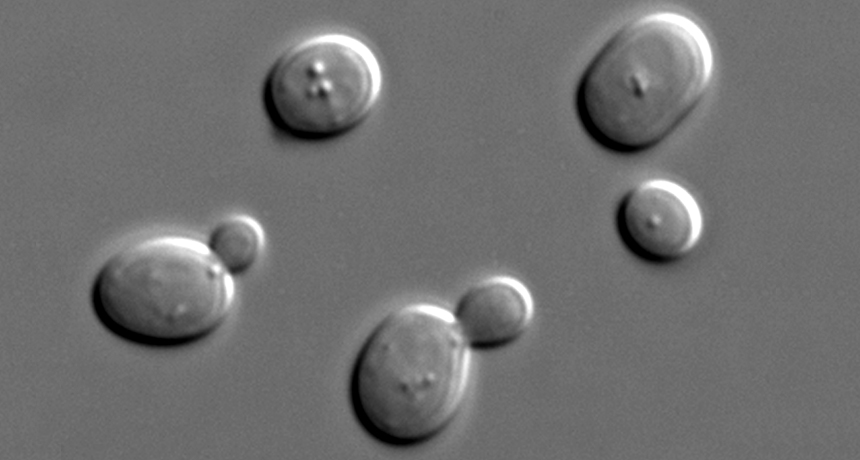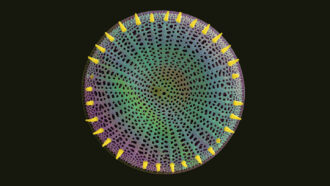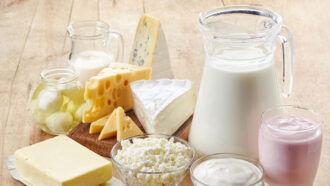A success for designer life
A newly made artificial chromosome marks a big step toward lab-made organisms

In dough, these yeast cells help bread rise. In the lab, scientists have found a way to make a new chromosome for the organism. It's a first step toward creating an entirely synthetic organism.
MASUR/WIKIMEDIA COMMONS
We already customize everything from cars to computers. This makes them look and behave how we want them to. Scientists now are finding ways to custom-build microbes, too. These miniature life forms might one day be tweaked and tailored to produce food, fuel or life-saving drugs.
That effort just took a big step forward. Researchers report they have just built a synthetic yeast chromosome.
Chromosomes are the threadlike structures in the nucleus of a cell that carry genes. Those genes determine much of how an organism looks and behaves. In the lab, yeast cells adopted the synthetic chromosome and continued to grow. That means the experiment was a success. A team of scientists that included dozens of university students reported the advance on March 27 in Science.
Equally important, the researchers altered the chromosome in important ways. That showed it may be possible to give an organism new traits. And these might permit a life form to do things it can’t do now.
Previously, researchers synthesized bacteria’s chromosomes. Those were very simple and fairly easy to make. The synthetic yeast chromosome is the first ever assembled from an organism that is a eukaryote (You KARE ee oat). This domain of life includes animals, plants and fungi (yeast is a fungus). Eukaryotes store DNA in the nuclei of their cells. Their chromosomes are more complex than those of bacteria.
The advantage of a synthetic chromosome is that it allows scientists to pick and choose which genes they want to include — or exclude. Eventually, if researchers can synthesize all 16 yeast chromosomes, they might be able to build in the lab an entirely new organism. Although artificial, such a synthetic organism also might prove useful. It might be customized to produce biofuels or even vaccines. It also could help experts better understand the roles of genes.
Genetic engineering on steroids
Scientists who work on custom organisms are known as synthetic biologists. To create the new chromosome, these biologists started with chromosome III from Saccharomyces cerevisiae(SAK row MY seez Ceh reh VIZ ee eye). People share a long history with this species. We have used it for thousands of years to make bread, beer and wine.
A chromosome is a long and twisted molecule of DNA. To create the synthetic chromosome, scientists snipped some pieces of DNA out of the yeast’s chromosome III. Then they came up with a way to scramble other segments of the chromosome. That scrambling could yield a chromosome with new properties.
Jef Boeke calls the work “genetic engineering on steroids.” He’s a yeast geneticist at New York University. He helped build the new chromosome when he was at Johns Hopkins University in Baltimore, Md.
A chromosome may be small, but building a synthetic one took a very big effort. Some members of the team had to break down the original yeast chromosome into DNA building blocks. Others snapped those building blocks together to create larger chunks. Finally, the researchers inserted the large chunks of DNA into yeast cells.
The yeast did the rest. Its cells can swap bits of DNA where parts match. Here, yeast cells swapped out swaths of their own genes for the synthetic chunks of DNA. Through repeated experiments, the scientists coaxed the yeast into replacing an entire chromosome, chunk by chunk. This left the yeast cell with a chromosome made entirely of engineered chunks.
Boeke and his colleagues reported that yeast cells with the synthetic chromosome grew as well as all-natural cells.
“The fact that it grows as well as it does is really encouraging,” Philip Weyman told Science News. A synthetic biologist at the J. Craig Venter Institute in La Jolla, Calif., he did not work on the study.
Boeke says his group now hopes to produce a completely synthetic yeast genome — which refers to all the genes, on all the chromosomes. And their goal is to have it done in three to five years.
Power Words
biology The scientific study of life.
chromosome A single threadlike piece of coiled DNA found in a cell’s nucleus. A chromosome is generally X-shaped in animals and plants. Some segments of DNA in a chromosome are genes. Other segments of DNA in a chromosome are landing pads for proteins. The function of other segments of DNA in chromosomes is still not fully understood by scientists.
DNA (short for deoxyribonucleic acid) A long, spiral-shaped molecule inside most living cells that carries genetic instructions. In all living things, from plants and animals to microbes, these instructions tell cells which molecules to make.
eukaryote Any organism whose cells have a nucleus. Eukaryotes include all multicellular creatures (such as plants, animals and fungi) as well as certain types of single-celled microorganisms.
fungus (plural: fungi) Any of a group of unicellular or multicellular, spore-producing organisms that feed on organic matter, both living and decaying. Molds, yeast and mushrooms are all types of fungi.
gene A segment of DNA that codes, or holds instructions, for producing a protein. Offspring inherit genes from their parents. Genes influence how an organism looks and behaves.
genetic engineering The direct manipulation of an organism’s genome. In this process, genes can be removed, disabled so that they no longer function, or added after being taken from other organisms. Genetic engineering can be used to create organisms that produce medicines, or crops that grow better under challenging conditions such as dry weather, hot temperatures or salty soils.
genetic Having to do with chromosomes, DNA and the genes contained within DNA. The field of science dealing with these biological instructions is known as genetics.
microbe (short formicroorganism) A living thing that is too small to see with the unaided eye, including bacteria, some fungi and many other organisms such as amoebas. Most consist of a single cell.
nucleus Plural is nuclei. (in biology) A dense structure present in many cells. Typically a single rounded structure encased within a membrane, the nucleus contains the genetic information.
synthetic biology A research field in which scientists work on developing custom life forms in the lab. Because they make synthetic organisms, scientists who work in this field are known as synthetic biologists.







